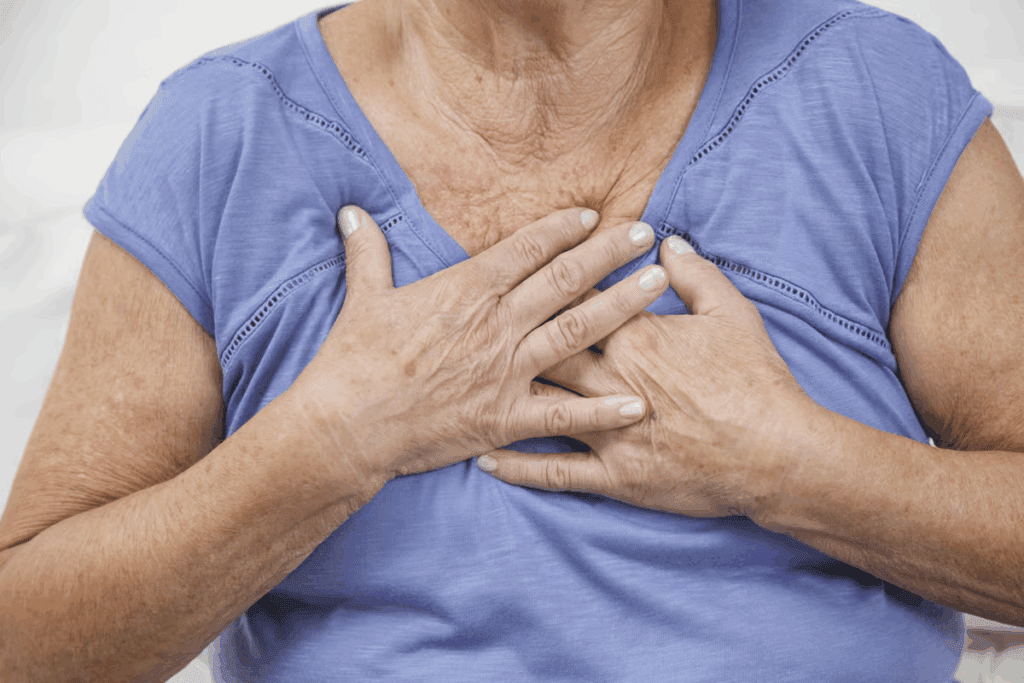Last Updated on October 31, 2025 by Batuhan Temel

Learn to define angina and 10 key symptoms of chest pain radiating to neck, jaw, and shoulders.
Chest pain or discomfort that spreads to the neck, jaw, or shoulders might mean you have angina. This is a sign of less blood getting to your heart. At Liv Hospital, we know how vital it is to spot these signs early. This way, we can offer top-notch heart care right away.
Angina often feels like pressure, tightness, or a burning in your chest. It usually happens when you’re active and goes away when you rest. Spotting these signs is key to preventing heart problems.
We focus on caring for our patients with compassion and the latest medical techniques. Knowing about angina symptoms is the first step to managing and treating it effectively.

Angina happens when your heart doesn’t get enough oxygen-rich blood. This is often because of reduced blood flow to the heart muscle. This usually comes from coronary artery disease. Knowing how angina works is key to managing it and avoiding worse heart problems.
Angina is mainly caused by a temporary drop in blood flow to the heart muscle. This happens when the coronary arteries, which bring blood to the heart, get narrowed or blocked. The main reason for this narrowing is plaque buildup on the arteries’ inner walls.
When the heart muscle doesn’t get enough oxygen, it can cause chest pain or discomfort. This is known as angina. The heart’s need for oxygen and the arteries’ ability to supply it are at the heart of angina.
While coronary artery disease is the top cause of angina, other heart issues can also cause it. For example, coronary microvascular disease affects the heart’s smaller blood vessels. This can also lead to angina. Other conditions, like hypertrophic cardiomyopathy, can cause angina too.
Other factors like anemia, thyroid disorders, and infections can also cause angina. They can either lower the blood’s oxygen-carrying ability or make the heart work harder. Knowing these causes is important for finding the right treatment.

The medical world sees angina as a sign of a heart problem, often linked to coronary heart disease. It’s when the heart muscle doesn’t get enough oxygen-rich blood. This happens because of narrowed coronary arteries.
Doctors define angina by its symptoms. These include chest pain or discomfort that might spread to the neck, jaw, shoulders, or back. The pain feels like pressure or squeezing.
To spot angina, doctors look at the patient’s history, symptoms, and test results. They use things like electrocardiograms (ECGs) and stress tests.
When diagnosing angina, doctors check how severe, long-lasting, and what triggers the pain. Stable angina happens when you exert yourself or get stressed. Unstable angina can happen without any effort and is a sign of a serious issue.
Telling angina apart from other chest pains is key. Other pains might come from the stomach, muscles, or lungs. But angina is about reduced blood flow to the heart.
Doctors look at the pain’s type, other symptoms, and the patient’s overall health. For example, angina often comes with shortness of breath or nausea. But sharp, stabbing pains might be from muscles.
Knowing the difference helps doctors give better care. Accurate diagnosis and treatment can prevent serious problems. It also improves life quality for those with angina.
Angina is a condition that causes chest pain. It comes in three main types, each with its own triggers and signs. Knowing these differences is key for the right diagnosis and treatment.
Stable angina is the most common type. It happens when you exert yourself or feel stressed. The pain usually goes away when you rest or take your medicine.
For example, someone with stable angina might feel chest pain when they walk uphill. Or when they’re under a lot of emotional stress. But the pain goes away when they rest or take their medicine.
Unstable angina is a more serious condition. It can happen at any time, even when you’re resting. It’s not always helped by rest or medicine.
Unstable angina is a sign that you might be having a heart attack. If you have chest pain or discomfort that’s new, getting worse, or happens when you’re resting, get emergency help right away.
Variant or Prinzmetal angina is caused by spasms in the coronary arteries. It can happen when you’re resting and is often seen on an electrocardiogram. This type of angina can be very severe and needs special treatment.
Coronary spasms can be triggered by cold, stress, or certain medicines.
It’s important to know the differences between these types of angina to manage and treat them effectively. If you’re having angina symptoms, talk to your doctor to figure out the best plan.
Angina often feels like pressure or heaviness in the chest. This can be scary for those who feel it. It happens when the heart muscle doesn’t get enough oxygen-rich blood, usually because of blocked arteries.
The feeling of angina is like tightness, squeezing, or pressure in the chest. It might also feel like a dull ache or a heavy weight. This is because the heart muscle isn’t getting enough oxygen, often because of poor blood flow.
Angina episodes are usually short-lived, lasting 5 to 15 minutes. But sometimes, they can last up to 30 minutes. If the pain lasts longer or is very severe, you should get medical help right away.
Knowing about angina symptoms and how long they last is key to managing the condition. Spotting these signs early can help you get the right care quickly. This could stop more serious heart problems.
Pain in the neck and jaw can be a sign of angina. This happens because the nerves that connect to the heart also reach the neck and jaw. This creates a shared path for pain signals.
Pain from angina can spread to the neck and jaw. This is because of the complex nerve network. The nerves that carry pain from the heart also connect to the neck and jaw. So, when the heart gets less blood, pain can move to these areas.
Knowing when neck and jaw pain is from angina is key. This pain feels like a dull ache or tightness. It can start with hard work or stress and goes away with rest or medicine.
To tell if neck and jaw pain is from angina, look for these signs:
Knowing these signs can help you spot angina-related pain. This might lead you to get checked by a doctor.
Angina often causes pain in the shoulders and arms. This is a key sign of the condition, often seen with chest pain. Knowing how shoulder and arm pain acts can help spot angina.
Pain from angina usually goes to the left side. This is because the heart is on the left, and nerves send pain signals there. But, pain can also be on the right or both sides.
How pain spreads can differ for everyone. It depends on the heart’s blood vessels and body shape.
The arm pain from angina can feel different. It’s often a discomfort or ache, not a sharp pain. Some feel a heaviness or squeezing in their arm, like chest pain.
Any arm or shoulder pain that doesn’t make sense, with chest pain or shortness of breath, needs a doctor’s check.
Beyond chest pain, angina can also cause discomfort in the back and difficulty breathing. These symptoms can be just as alarming and require immediate attention.
Angina can sometimes cause pain that radiates to the back. This happens because the nerves that supply the heart also supply other areas of the body, including the back. When chest pain shoots to your back, it can feel like a dull ache or a sharp stabbing sensation.
“The pain associated with angina can be referred to the back, making it essential to consider this symptom when evaluating chest pain.” – This is a key point to remember. Back pain can be a symptom of angina, even if the pain starts in the chest.
Shortness of breath is another symptom that can occur during an angina episode. This happens because the heart is not getting enough oxygen. It can make you feel like you can’t catch your breath.
It’s important to know that shortness of breath can happen with or without chest pain. If you suddenly find it hard to breathe, you should get medical help right away.
“Shortness of breath is a critical symptom that should not be ignored, as it can be a sign of an underlying heart condition.”
Understanding these symptoms can help you know when something is wrong. If you’re experiencing back pain or shortness of breath along with chest discomfort, don’t hesitate to seek medical help.
Beyond chest pain, angina can also show up as fatigue and stomach issues. These symptoms can be tricky to spot, making it hard to catch angina early.
Feeling extremely tired without reason is a common sign of angina. It happens when the heart doesn’t get enough oxygen-rich blood. This can make you feel weak or tired all the time, even after resting.
Key characteristics of angina-related fatigue:
A study in the Journal of the American College of Cardiology found that fatigue is a big problem for people with angina. It really affects their quality of life.
“Fatigue is a complex symptom that can have multiple causes, but in the context of angina, it is a signal that the heart is under strain.”
Nausea and indigestion can also be signs of angina. But, people often think they’re just stomach problems.
| Symptom | Angina-Related | Gastrointestinal Issue |
| Nausea | Often accompanies other angina symptoms like chest pain | Usually associated with eating or specific foods |
| Indigestion | Can be triggered by exertion or stress | Typically related to meals or certain foods |
It’s key to know that these symptoms can mean different things. A doctor’s check-up is needed to figure out what’s really going on.
We stress the need to know about these hidden angina signs. If you or someone you know keeps feeling tired, nauseous, or has indigestion, and it’s with other angina symptoms, get medical help right away.
Angina can cause symptoms like sweating, dizziness, and anxiety, aside from chest pain. These signs are important to notice. They might mean there’s a serious heart problem.
Sweating, or cold sweats, is a common reaction to angina. It happens because the body is stressed. Cold sweats can mean the heart isn’t getting enough oxygen. It’s important to take this seriously.
Dizziness or feeling off-balance can also happen with angina. It might be because the heart isn’t sending enough blood to the brain. Feeling dizzy with chest pain means you should get medical help right away.
Some people feel like they’re going to die or feel extreme anxiety during an angina episode. This is because the body is under a lot of stress. The heart’s struggle to get enough oxygen can make you feel scared or anxious.
| Symptom | Description | Possible Cause |
| Cold Sweats | Sweating or clamminess without an apparent reason | Body’s stress response to angina |
| Dizziness | Feeling off-balance or lightheaded | Reduced blood flow to the brain |
| Anxiety | Feeling of impending doom or severe anxiety | Physiological stress triggering a fear response |
Knowing these symptoms can help you know when to get medical help. If you or someone you know is showing these signs, it’s important to seek medical attention.
Classic angina symptoms are well-known, but women and older adults often show different signs. These unique symptoms can make diagnosis and treatment harder. It’s important for doctors to know about these differences.
Studies show women are more likely to have angina symptoms that don’t seem like heart problems. They might feel sharp, stabbing pains instead of the usual chest pressure. Women can also get pain in their back, neck, or jaw, and feel unusual fatigue or shortness of breath without chest pain.
A study in the Journal of the American College of Cardiology found women with angina often have non-obstructive coronary artery disease. This can cause different symptoms than men. It shows we need a better understanding of angina in women.
“The presentation of angina in women often deviates from the classic male pattern, necessitating a broader consideration of symptoms in clinical practice.”
— Dr. Jane Smith, Cardiologist
Elderly patients can also have different angina symptoms. This is because of changes in the heart and other health issues with age. They might feel dizziness, confusion, or a general feeling of being unwell during an angina episode, instead of the usual chest pain. These symptoms can be mistaken for other age-related conditions, which can delay diagnosis and treatment.
It’s key to recognize these atypical symptoms for timely and effective angina management in elderly patients. Doctors need to be careful and think of angina when elderly patients have unexplained or non-specific symptoms.
It’s important to know when you need emergency care for angina. Angina symptoms can sometimes mean a heart attack is happening. We’ll tell you when to get help right away.
Angina symptoms that don’t go away with rest or medicine are a worry. If chest pain lasts longer or is worse, get emergency care. Also, if you can’t breathe well, feel dizzy, or have cold sweats, act fast.
Certain symptoms mean you need emergency care right away. These include:
If you or someone you know has these symptoms, act fast.
| Symptom | Action |
| Chest pain not relieved by rest or medicine | Seek emergency care |
| Difficulty breathing | Call emergency services |
| Dizziness or lightheadedness | Seek immediate medical attention |
When you call for emergency help, tell them everything about your symptoms. This includes:
Knowing about angina and its signs is key to keeping your heart healthy. Spotting symptoms like chest pain spreading to the neck, jaw, and shoulders helps. This way, you can get medical help early and boost your heart health.
Handling angina means knowing its signs and taking charge of your heart. This includes changing your lifestyle, following your meds, and watching for symptoms. By being active in managing your condition, you can lower heart risks and live better.
We urge you to be proactive in caring for your heart. Learn about angina and its symptoms. This way, you can manage your condition, make smart health choices, and work with your doctor for the best heart health.
Angina is when your heart doesn’t get enough blood. It feels like chest pain or discomfort. This pain can spread to your neck, jaw, and shoulders.
Angina usually happens because of blocked heart arteries. But, other heart issues can also cause it.
There are three main types of angina. Stable angina happens when you exert yourself. Unstable angina is a serious warning sign. Variant angina is caused by spasms in the arteries.
Angina chest pain usually lasts between 5 to 15 minutes.
The nerves that supply the heart also go to the neck and jaw. This is why you feel pain there.
Yes, women and older adults might have different symptoms. It’s important to know these differences for a correct diagnosis.
Call for help right away if you have severe chest pain or trouble breathing. Also, seek help for cold sweats, feeling dizzy, or extreme anxiety.
Tell the emergency team about your symptoms’ start, how long they last, and how bad they are. Also, mention what makes them better or worse.
Yes, you can manage angina by understanding your symptoms and working with your doctor. This way, you can take care of your heart health.
Symptoms of angina include feeling tired, nauseous, or dizzy. You might also sweat a lot or feel anxious. These can be confused with other issues.
Angina is unique because it’s related to heart blood flow. Knowing this helps doctors diagnose it correctly, unlike other chest pain causes.
Arm pain from angina feels like a dull ache or heaviness. It can happen in either arm.
National Health Service (NHS). (2025). 10 Key Angina Symptoms Chest Pain Radiating to. Retrieved from https://www.nhs.uk/conditions/angina/
Subscribe to our e-newsletter to stay informed about the latest innovations in the world of health and exclusive offers!
WhatsApp us